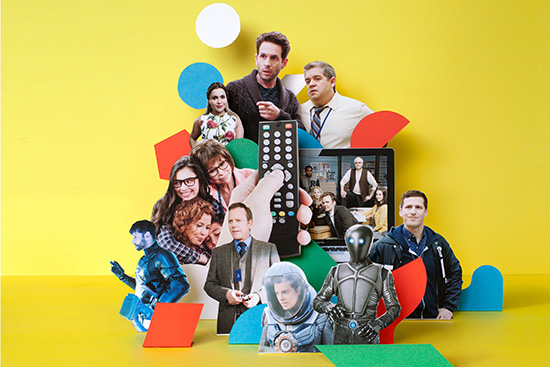电视行业新趋势:再也不用担心美剧被砍掉了

|
电视剧就像是如今众多热播剧中的僵尸一样,反正就是死不了。而且,即便被取消之后,越来越多的节目反而会换个电视台,或进驻数量越来越多的流媒体公司,来制作新剧集。 今年1月,电视剧《神烦警探》(Brooklyn Nine-Nine)在被福克斯(Fox)取消之后,又首次出现在了美国全国广播公司(NBC)。5月,漫画改编的电视剧《路西法》(Lucifer)在去年被福克斯取消之后,重新登上了Netflix。与此同时,前科幻频道剧集《苍穹浩瀚》(The Expanse)将于12月回归亚马逊Prime Video。 我们不妨将这种做法称之为“剧集交换”,它并非是什么新事物。数十年前,像《反斗小宝贝》(Leave It to Beaver)和《细路仔》(Diff’rent Strokes)等知名剧集在播出期间都曾经更换过电视台。 但在近几年,节目的换台频率明显有所加速,因为扩张中的有线网络电视和新流媒体服务都渴望获得视频内容。曾经被好莱坞视为“次品”的而取消的节目,如今则被看作是机会。毕竟,从零开发一个剧集要耗费数百万美元的成本。此外,很多被取消的节目在当前都拥有粉丝,他们必然会在Facebook和推特(Twitter)上热议剧集的复播。 Pop TV的总裁布拉德·施瓦茨表示:“在这个已经达到顶峰的电视生态圈中,我们难以投入精力来制作一些突破性的内容,你可以通过播放人们已经了解和喜爱的一些节目来获得些许优势。”作为哥伦比亚广播公司旗下的市场细分电视台,Pop TV最近开始播放来自于Netflix的电视剧《活在当下》(One Day at a Time)。 3月,Netflix取消了20世纪70年代末80年代初诺曼·里尔热播剧的翻拍剧《活在当下》,它讲述的是一个单身母亲和她孩子们的故事。三个月之后,Pop TV宣布将赋予该电视剧第二次生命(如果算上原创,应该是第三次了)。 施瓦茨说:“我们认为它与Pop TV十分契合。” 他的频道计划全力推广其新接纳的剧集,以便尽可能在该剧明年回归时揽获更大的受众群。但施瓦茨还指出,Pop TV所认为的成功与视频流巨头Netflix的看法之间还存在着巨大差距。 施瓦茨说:“如果有500万人观看《活在当下》,这可能对Netflix来说并不算多,但对我们来说就很不错了。” Netflix并没有回复《财富》杂志的置评请求,而且从未公布过《活在当下》的收视率。该剧播出了三季。 弗若斯特沙利文咨询公司(Frost & Sullivan)的分析师丹·雷布恩表示,总的来说,财大气粗的流媒体公司的高速发展至少是导致美剧交换日渐频繁的其中一个原因。除了像Netflix、亚马逊Prime以及Hulu等大牌之外,新面孔包括即将面世的苹果TV+和Disney+,以及NBC环球(NBCUniversal)的流媒体服务和华纳媒体(WarnerMedia)的HBO Max。 雷布恩表示,像《奥维尔号》(The Orville)这样的科幻电视剧将于2020年年底从福克斯挪至Hulu。这部剧集并没有被取消,相反,其制作者塞斯·麦克法兰对这一举措进行了解释,他们难以在福克斯换季档期间按时向福克斯交付这一电视剧。雷布恩表示,换台播出对于一些节目来说是正常的,因为这种方法“能够为剧集带来灵活度、创造力以及不同的营销方式。” 当然,得到拯救的剧集并不一定就能存活。例如,Netflix在7月取消了《指定幸存者》(Designated Survivor)。该剧来自于ABC,仅在Netflix播放了一季。 节目交换出现了一个相对较新的形式:对于从电视台交换至流媒体公司的剧集,其版权依然属于电视台。7月便出现了这一事件,当时NBC环球以这种方式将NBC最近取消的高中喜剧《疯狂教授生物课》(A.P. Bio)让渡给了流媒体公司。 猎头公司Creative Artists Agency的代理罗伯特·肯尼利预计,随着好莱坞适应流媒体带来的威胁和机遇,节目交换将继续发展。有一点是显而易见的,以前在电视行业十分少见的第二次机会,如今已经是习以为常。 肯尼利说,这对于制作者来说是一个“伟大的时代”。(财富中文网) 本文登载于《财富》杂志2019年9月刊。 译者:冯丰 审校:夏林 |
Television shows are a lot like the zombies that star in several of today’s hit series: They just won’t die. Instead, after being canceled, a growing number of shows are producing new episodes on a different channel or on one of the increasing number of streaming services. In January, sitcom Brooklyn Nine-Nine premiered on NBC after being dumped by Fox. In May, comic book–inspired series Lucifer reappeared on Netflix, after being canceled by Fox last year. Meanwhile, former Syfy drama The Expanse is slated to come back to life on Amazon Prime Video in December. The practice—call it show swapping, if you’d like—isn’t new. Decades ago, iconic series like Leave It to Beaver and Diff’rent Strokes switched homes during their runs. But in recent years, the pace has noticeably accelerated because of the proliferation of cable networks and new streaming services hungry for content. Once viewed by Hollywood as “damaged goods,” canceled shows are now considered to be opportunities. After all, developing a series from scratch costs millions of dollars. Furthermore, many canceled shows have existing fans who will inevitably gush about the revivals on Facebook and Twitter. “It’s so hard to get attention to break through in this peak-TV climate that you can be a little ahead of the game by having something people already know and love,” says Brad Schwartz, president of Pop TV, the niche CBS-owned network that recently picked up sitcom One Day at a Time from Netflix. In March, Netflix pulled the plug on One Day at a Time, a reboot of Norman Lear’s hit show from the late 1970s and early ’80s about a single mother and her kids. Three months later, Pop TV announced that it would give the show a second life (or third, if you count the original). “We thought it was a perfect fit,” Schwartz says. His channel plans to go all out in marketing its newly adopted series to get as big an audience as possible for its comeback next year. But Schwartz also points out the huge gap between what Pop TV considers success and what streaming giant Netflix does. “If 5 million people watch One Day at a Time, that might not be a huge hit for them, but it would be great for us,” says Schwartz. Netflix, which did not respond to Fortune’s requests for comment, has never publicly discussed viewership numbers for One Day at a Time, which ran for three seasons. In general, says Dan Rayburn, an analyst at Frost & Sullivan, the multiplying number of streaming services with deep pockets is at least partially responsible for the rise in show swapping. In addition to big players like Netflix, Amazon Prime, and Hulu, newcomers include the upcoming Apple TV+ and Disney+, as well as NBCUniversal’s streaming service and WarnerMedia’s HBO Max. Rayburn says a show like The Orville, a sci fi dramedy that will move to Hulu from Fox in late 2020, could thrive at its new home. The series wasn’t canceled. Instead, its creator, Seth MacFarlane, has explained the move by saying it was difficult to deliver the show to the network in time for its mid-season slot. Rayburn says shifting to streaming can make sense for some shows because the medium “lends itself to flexibility, creativity, and a different way of marketing.” Of course, just because a series is rescued doesn’t mean its survival is guaranteed. For example, in July, Netflix killed political thriller Designated Survivor, which it had adopted from ABC, after just one season. A relatively new wrinkle in the show-swap phenomenon is the series that switches from broadcast to streaming but stays in the corporate family. That happened in July, when NBCUniversal’s planned streaming service picked up NBC’s recently canceled high school comedy A.P. Bio. Rob Kenneally, an agent at talent firm Creative Artists Agency, expects show swapping to continue evolving as Hollywood adapts to the threat and opportunity of streaming. What is clear is that second chances, once relatively rare in TV, are now routine. Says Kenneally, it’s “a great era” for creators. This article appears in the September 2019 issue of Fortune. |













